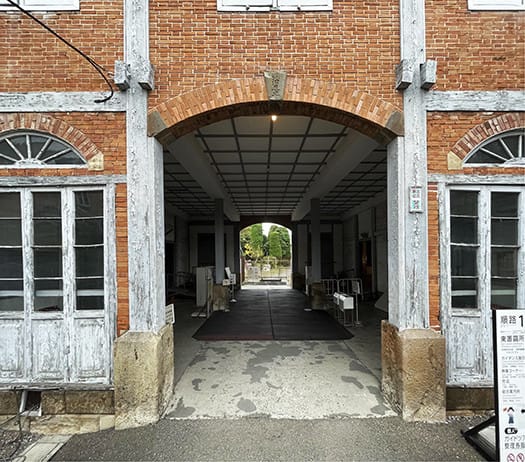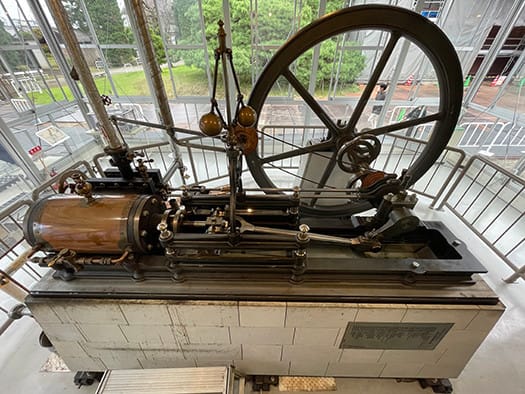


江戸期の古民家を探訪することが多いわたしですが、とくに最近行った福島市民家園では、多くの古民家で「養蚕〜機織り」が家内制手工業として営まれている様子に触れていた。また、ツルの恩返しという古民俗の様子もいかにも地域密着で根付いている様子がわかる。
そんなことから当然のこととして、幕末〜明治の日本の製造業の基盤を形成し、そして世界に日本の存在を強く訴求した生糸生産・製品輸出の根源地になった富岡製糸場について、訪問して詳細にその根幹を取材したいと思うに至っていました。仕事生活の一段落からあらたな行動の方向性として、建築と人間社会みたいな領域を掘っていきたいという願いのひとつのあらわれでしょうか。
歴史が好きでいろいろな探究をしていましたが、ふしぎとこの富岡製糸場のことは抜けていた。富岡製糸場の建設はフランス人指導者ポール・ブリュナの計画書をもとに1871(明治4)年から始まり翌年の1872(明治5)年には主な建造物が完成し操業が開始。繭から生糸を取る繰糸所では全国から集まった伝習工女たちが働き、本格的な器械製糸が始まった。ということで、先日の出張で足を伸ばしてようやく現地取材の機会を持つことが出来た。やはり建築の仕様ひとつをとってもいろいろな発見に満ちていた。
ポール・ブリュナの言葉として「明治維新はフランス革命と同等」という位置付けをされていることがあり、日本の明治以降の近代化・工業社会化というものは人類史の中でも特筆すべき事柄なのだと思い至った。建築という側面からも、それまでの日本建築からは大きく隔絶した歴史を刻みつけている。従来は、北海道人として開拓期の「洋造」建築からの流れという視点に偏っていたかも知れない。
それとはまた違う日本の近代化の流れ、とくに製造業の世界最先端化ということを生み出した、富岡製糸場の経験知は、ひろく日本社会の自信を呼び起こしていったのだと思う。さすがに明治ニッポンの国を挙げた産業育成・勃興にまつわる全体像なので、まだ取材の整理途上。だけれど、気付かされたことは膨大で、すこしづつ紡ぎ出すように振り返って見たいと思う次第です。
たしかに明治維新というのは、今日の工業化現代国家・ニッポンの礎石だと強く実感する。世界史のなかでも地球規模でモノが行き交う交易の時代の始まりであり、その変革への対応で日本は独自の地位を獲得していった。温故知新。今日の日本は一歩間違えば、大きな停滞に直面するかも知れない。そうならなかった明治の決断に迫ってみたい。
English version⬇
Tomioka Silk Mill, the origin of Japanese manufacturing
The Meiji Restoration, a direct social reform that continues to the present day. How was the Japanese manufacturing industry, which surprised the world, created? The ...
I often visit old private houses from the Edo period, and especially at the Fukushima City Minka-en, which I visited recently, I was exposed to how “sericulture - weaving” was being operated as a cottage industry in many old private houses. The ancient folk custom of repaying cranes for their kindness is also evident in the way it is rooted in the local community.
This naturally led me to want to visit the Tomioka Silk Mill, which formed the foundation of Japan's manufacturing industry from the end of the Edo period to the Meiji period and became the root of raw silk production and product export, which strongly appealed to the world about Japan's existence. This may be an expression of my desire to explore areas such as architecture and human society as a new direction of action after the end of my work life.
I love history and have done a lot of research on it, but I was surprised to find that I had not mentioned the Tomioka Silk Mill. The construction of the Tomioka Silk Mill began in 1871 based on the plans of a French leader, Paul Brunat, and the main buildings were completed and operation started in the following year, 1872. In 1872, the main buildings were completed and operations began. At the reeling factory, where raw silk was harvested from cocoons, apprentice workers from all over the country worked, and full-scale instrumental spinning began. I finally had a chance to visit the site on a recent business trip. As I expected, I was filled with various discoveries, even in terms of architectural specifications.
In the words of Paul Brunner, “The Meiji Restoration was equivalent to the French Revolution,” and I realized that the modernization and industrialization of Japan after the Meiji period is a matter of particular note in the history of mankind. From the aspect of architecture, too, the history of architecture in Japan is marked by a sharp departure from that of the past. As a Hokkaido-native, I may have been biased to the viewpoint of the flow from “Western-style” architecture of the pioneering period.
The experience and knowledge of the Tomioka Silk Mill, which gave birth to a different trend of Japan's modernization, especially the world's most advanced manufacturing industry, must have aroused the confidence of Japanese society at large. As one would expect from the overall picture of the development and rise of industry in Meiji Japan, I am still in the process of organizing my coverage. However, I would like to look back at what I have learned and see what I can learn from it.
Indeed, I strongly feel that the Meiji Restoration was the cornerstone of today's modern, industrialized Japan. It was the beginning of an era in world history in which goods were traded on a global scale, and Japan achieved a unique status by responding to these changes. The new age of learning from the past. One misstep and Japan today could face major stagnation. We would like to look at the decisions made by the Meiji period that prevented this from happening.




























※コメント投稿者のブログIDはブログ作成者のみに通知されます